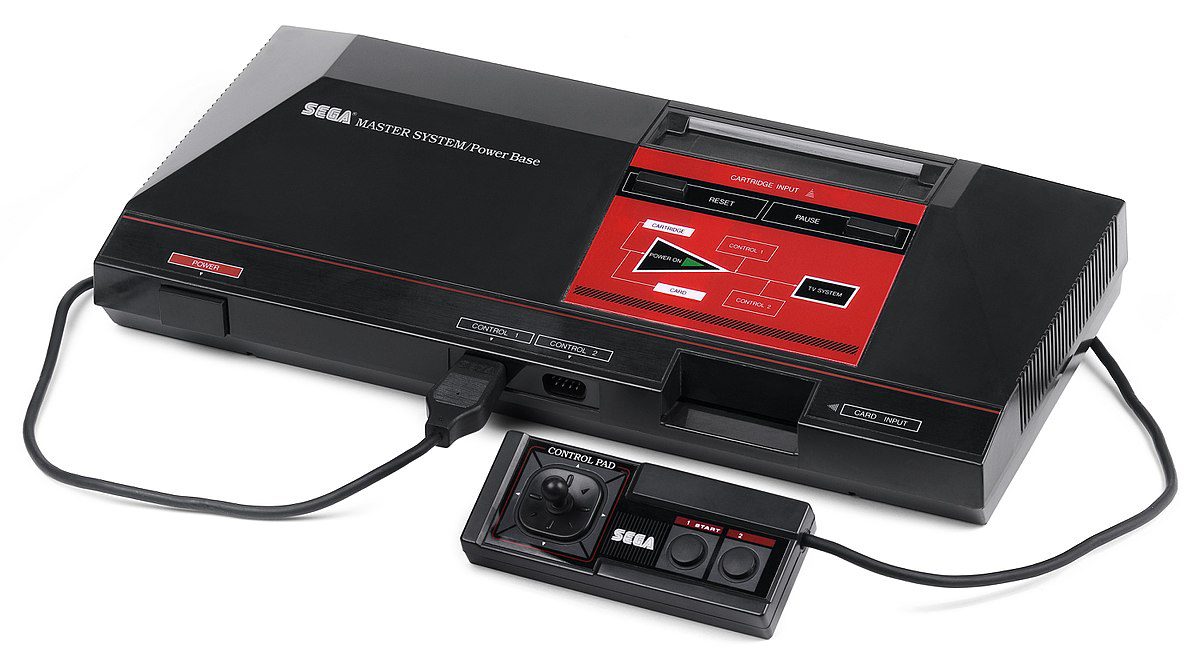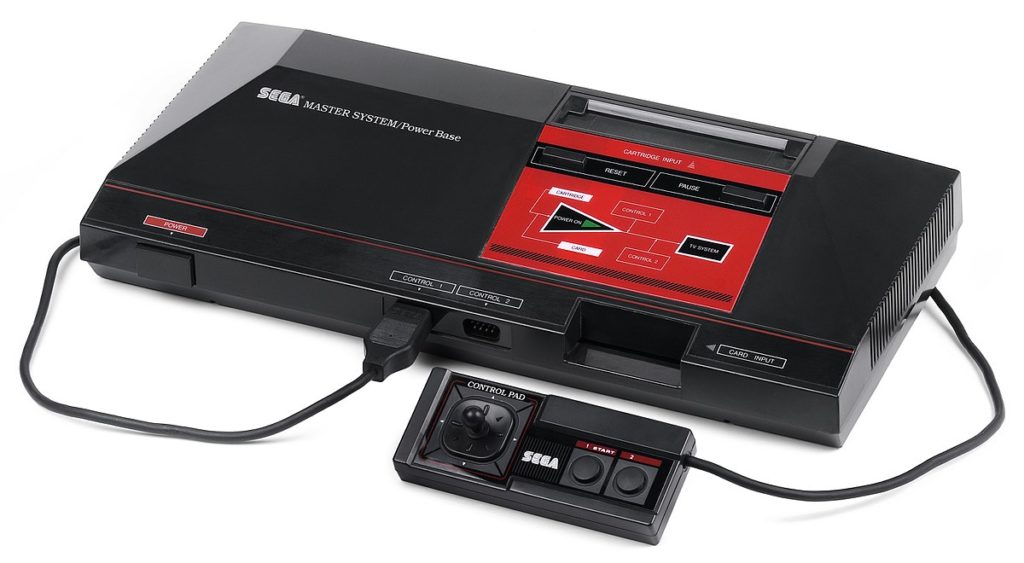

Remember when you had a Nintendo Entertainment System (NES)? Oh, come on, we all know you did. A good ninety percent of gamers had them, so don’t try to weasel yourself out claiming you just had a Master System. I did back in the very late eighties and early nineties and one out of three American households did. Even so, the Master System featured some awesome games such as the first Phantasy Star game, the Alex Kidd series, and awesome arcade ports. Now, let’s move on to the brainchild of Sega.
The Master System or, in Japan, SG-1000 Mark III was the last of the SG-1000 product series, and the only devoted video game console out of the three systems. While the SG-1000 and SC-3000 enjoyed a moderate success, the Master System was set out to combat Nintendo‘s ultimate weapon. 1985 marked the release of the Mark III in Japan and was visually identical to the Mark II. However, this system held hardware enhancements. The processor was speedy in its time with a Zilog Z80 3.6 MHz CPU. Graphics were also improved with a meager, but slightly significant upgrade in on screen sprites; now 64 instead of 32. Perhaps the most noteworthy addition is was a PCM sound synthesizer chip, creating six audio channels. This eradicated the beeps of previous consoles with something that could be considered music.
This console also marked two “firsts”. First off, it toyed with virtual reality. Using supped up 3D movie glasses, each lens would briskly toggle among opaque and clear. While this was happening, on-screen graphics would have to be consistent with the glasses, thus creating a nearly seamless semi-virtual environment. Crude, but still effective to this day. Secondly, it was the first system to use two formats for gaming. The eight bit standard cartridges were used, but a cheaper, market friendly four bit “game card” was created. These games tended to be smaller due to obvious size and memory limitations, but subsequently, much cheaper. This provided a great way for us gamers with almost no cash buy games for their beloved system.
When the NES hit (or literally tackled) the market, Sega found itself in a steep declining of sales. With great games and a cheap price no one could hate, the NES fiercely ripped the gaming market from Sega, and any other competitor for that matter, and took it as its own. Sega had to alter their game plan, and so they gave life to the Master System, aka Mark III (Read above) using some of the most advanced hardware available in the current 8-bit technology. This marked the first of any console to be widely distributed in the US, but that didn’t stop Nintendo’s reign over the gaming market. On launch, an approximate of 175,000 consoles were sold on its first market quarter (Three months) with each system costing 200 dollars.
CEO of Sega, Hayao Nakayama, had a distaste of a 16 to 1 ratio of system sales when compared to Nintendo’s. Figuring he better hand out the marketing and such to Tonka, an American toy company, official preparations were made and carried out in 1988. This turned out to be the idiot’s move as Tonka had no idea on marketing of video games. While everyone knew about the cool, awesome, super-duper NES, most people would scratch their heads at the mention of the Master System. Why? Tonka had no initiative. Due partly with their lack of any know-how, but also what I believe: a little with laziness. After all, they had millions. Why take the time to take video game marketing 101 when they could blindly stumble and hope to succeed? At any rate, Tonka managed to snag two third party developers, the now well know Activision, and Parker Brothers, the board game company. It was probably not too much their fault on that blunder as Nintendo was a pre-Microsoft. That’s right, monopolizing any third party developer they could into an agreement basically saying they were developing for the NES, and only the NES. This severely damaged the system status and chance of succeeding. Sega, Activision, and Parker Brothers couldn’t possibly keep up with the sheer games coming out for the NES, and ultimately had a smaller library of games in the end… or at least in the US. Let’s take a trip down to Europe.
Amazingly, there was some areas where the NES and its power didn’t penetrate. One of the main one locales was Europe. Never had been introduced to a gaming system, or even the NES, Europeans jumped on the Master System when it was released in the fall of 1987. Also, instead of two developers, Europe received fourteen. These are Absolute, Activision, Acclaim, Codemasters, Core, Domark, Flying Edge, Image Works, Sony Imagesoft, TecMagik, Tengen, U.S. Gold, and Virgin. Nintendo was never able to retrieve the Europe market for Sega, one Master System victory. This particular victory lasted until 1996 despite the fact better consoles were out there.
Tec Toy, a small company, released their version of the Master System, the Master System Three in the late eighty’s. With minor aesthetic changes, the revised console only featured built-in games as a new incentive. However, some games were re-created with more familiar Brazilian characters, and translated into Portuguese. Later on Game Gear game ports were created for the Master System, such as the notable Sonic games. Perhaps most unique of all is the only licensed 8-bit port of Capcom’s popular Street Fighter 2.
Despite wooing Europe over, Sega still had loss the 8 bit race, and wasn’t quite sure what to do. Tonka had screwed up any chance for the US Master System to succeed, the smaller, sleek Master System II released in 1988 died quickly, but suddenly Sega had a revelation. They thought with the utter success of the black and white color portable Game Boy system from Nintendo, they could make use with the Master System. Sega’s plan? Cram a Master System (With a few improvements) into likewise portable package, except much bigger length wise with a wide area for your hands. Released in 1990, it sported an awesome color screen, and graphics far surpassing the Game Boy’s, it also drained batteries like crazy. This turned off most casual gamers, and most went with the Game Boy’s and Nintendo’s recognition by name. After all, Little Billy didn’t want to spend money on six more double A batteries for every six or so hours of game play on the Game Gear when he could squeeze 10 to 12 hours of gaming with only four batteries on the Game Boy.
If Nintendo owning 90% the gaming market shocked you, it should of. It was plainly illegal. Binding third party developers to an exclusive contract with just Nintendo was wrong, and by the time of 1992, the Japanese and American governments were starting to get angry, and Nintendo toned down. All ready too late for the Master System for it was gone except in Brazil and Europe.
Now that we’ve gone over the system that should’ve of started it all, but didn’t, we can come to appreciate really good business tactics: Who knows, what if Sega won the 8 bit war? We’d probably see the same cunning tactics on future systems (Sega CD, Sega 32X, etc.) and maybe a future filled with Sega consoles. But, for now, pick up a Master System just for the heck of it, and live in Sega’s past.
Processors
– Zilog Z80 CPU running at 3.58 MHz
– Texas Instruments SN-76596 PCM audio processor (6 channel sound)
– Yamaha YM-2413 OPL-3 FM synthesizer (FM module for Sega Mark III only)
Graphics
– Texas Instruments TMS9929A VDP
– 64K VRAM
– 16-color palette with 16 intensities each (64 colors from a 256-color palette)
– Support for 256×192 (SC-3000) and 240×226 (native) graphics display modes
– 32×28 character text display mode
Memory
– 1 MB system ROM
– 64 K system RAM
Connection
– 1 expansion slot (unused)
– 1 cartridge port
– 1 Game Card slot
– 2 joystick ports
– Commodore-style A/V port and internal RF adapter
Storage
– SG-1000 style videogame cartridges (supports ROM sizes from 128K to 4 MB)
– Sega Game Cards (supports ROM sizes from 32K to 256K)
CREDIT… Anthony and (now defunct) “Sega Base”, web site.

Leave a Reply